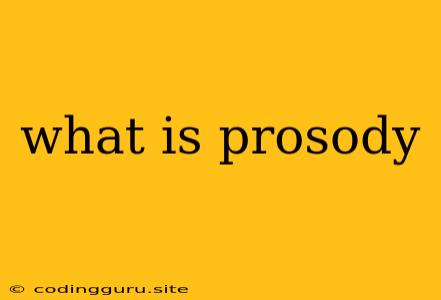What is Prosody? Unveiling the Rhythms and Melodies of Language
Prosody is a fascinating aspect of language that goes beyond the simple understanding of individual words. It's the music of speech, the rhythm, stress, intonation, and pauses that breathe life into our communication. Imagine reading a poem aloud. The way you emphasize certain words, the rise and fall of your voice, the silences you insert – these all contribute to the poem's emotional impact and meaning. This is the power of prosody in action.
Beyond Words: The Essence of Prosody
But prosody isn't just about reading poetry. It permeates all forms of spoken language, from everyday conversation to formal presentations. Think about how you might change your tone when asking a question versus making a statement. You might speak more slowly and emphasize certain words to convey seriousness, or you might speed up and use a higher pitch to express excitement. This dynamic interplay of vocal elements is what prosody is all about.
Why is Prosody Important?
Prosody plays a crucial role in how we understand and interpret speech. It helps us to:
- Disambiguate meaning: Consider the sentence "I saw the man with the telescope." Depending on how you emphasize the words, the meaning can change completely. Do you see the man who has a telescope, or are you using the telescope to see the man?
- Convey emotion: Our tone of voice can signal happiness, sadness, anger, or any other emotion. This adds depth and nuance to our communication.
- Enhance engagement: A speaker with good prosody is more likely to keep an audience's attention. They use variations in their voice to emphasize key points and make their speech more captivating.
Exploring the Components of Prosody
Prosody is a complex phenomenon, with several key components working together:
- Intonation: This refers to the rise and fall of the voice, often used to signal questions, statements, or emotional states.
- Stress: We emphasize certain syllables within words, and certain words within sentences, to highlight their importance.
- Rhythm: The pacing and flow of speech, often influenced by the structure of the language and the speaker's style.
- Pauses: Strategic silences that can add emphasis, allow for processing, or create dramatic effect.
Prosody in Action: A Practical Example
Let's look at a simple phrase: "I'm going to the store."
- Neutral intonation: A flat delivery, conveying a simple statement.
- Excited intonation: A higher pitch and faster tempo, expressing enthusiasm.
- Questioning intonation: A rise in pitch at the end, turning the statement into a question.
- Emphasized stress: "I'm going to the store, not the library."
By adjusting these elements, we can change the meaning and impact of this seemingly straightforward phrase.
Prosody and Technology: The Rise of Voice Assistants
The importance of prosody is not lost on technology. Voice assistants like Siri, Alexa, and Google Assistant rely on advanced algorithms to understand and respond to human speech. These systems are constantly being refined to interpret prosodic cues, making them more natural and responsive to our needs.
Conclusion: The Art of Speaking with Meaning
Prosody is more than just how we speak; it's the essence of how we connect with others. It's a powerful tool that allows us to express ourselves with nuance, convey emotion, and engage our listeners in a way that words alone cannot. As we continue to explore the intricacies of human language, the study of prosody will continue to reveal fascinating insights into how we communicate and understand each other.
